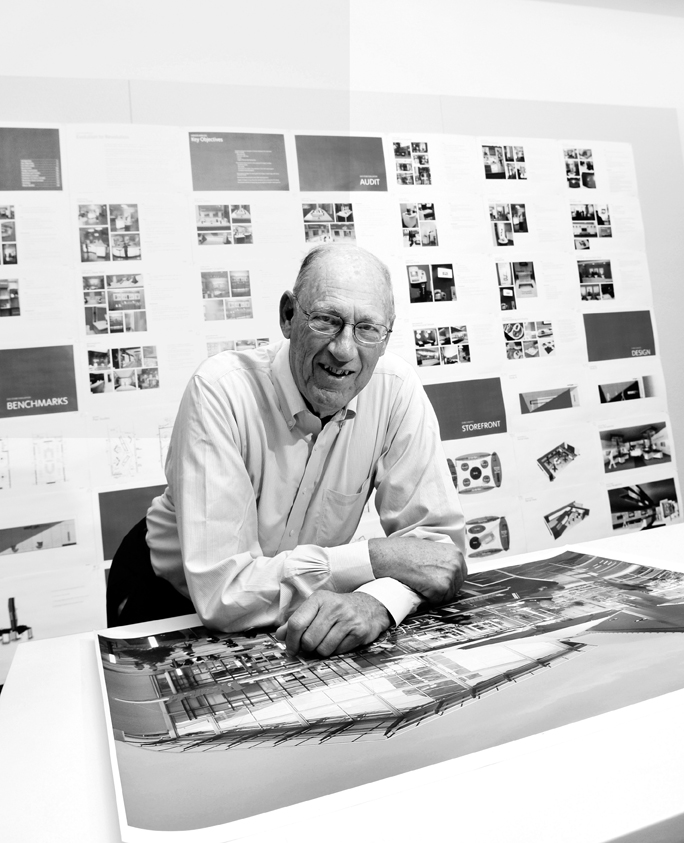After running what is today the largest architecture firm in the world for more than four decades, M. Arthur Gensler, Jr., FAIA, FIIDA, RIBA, is content to be just another employee at the firm that bears his name. “I sold my stock back to the firm, and now I consult with the leadership,” says the 76-year-old founder. “Sometimes they agree, sometimes they don’t. It’s advice, not instruction.”
Click here to read Gensler: 'The One Firm Firm", as well as the Gensler profile published in the November 2011 as part of BD+C's Best AEC Firms to Work For.
In fact, Gensler is at the San Francisco office every workday, when he’s not in China leading the firm’s Shanghai Tower project, or consulting with longtime client Sheldon Adelson, CEO of the Las Vegas Sands, or visiting a Gensler office somewhere in the world.
Gensler was born in Brooklyn, N.Y., in 1935. An only child, he grew up in West Hartford, Conn., and graduated from high school in Garden City, Long Island. His mother worked for the phone company. His father, known as “Slats”—no one called him by his first name, Millard, or Arthur, for that matter—sold ceiling tiles for Armstrong Cork Co. “He was one of the best architectural sales reps ever,” Gensler says of his father. “He was all about service to the client.” Years down the road that life lesson would shape the young man’s own business philosophy.
“I wanted to be an architect for as long as I can remember,” he recalls. At Cornell (“I was lucky to be accepted”), where he was an all-Ivy honorable mention soccer star, he met Drue Cortell, a Middlebury College student, at a New Year’s party in 1954. They married in 1957, and Gensler got his BArch the next year. Upon graduating, he fulfilled his ROTC obligation as a six-month wonder in the Army Corps of Engineers.
Then followed several years of job-hopping—in New York, with Shreve, Lamb and Harmon (architects of the Empire State Building), and in Kingston, Jamaica, with Norman and Dawbarn. After two years in Jamaica, his friend, Peter Flack (of engineers Flack & Kurtz), recommended him for a job running the New York office of architect Albert Sigal, who was designing schools that also served as fallout shelters. When the school funding dried up, Gensler decided to relocate to San Francisco with Sigal. In 1962, with three sons in tow (a fourth would come along later), he and Drue headed west, settling in the bayside town of Tiburon, in Marin County.
The new job turned out to be short-lived, so Gensler moved over to Wurster, Bernardi & Emmons, where he directed the development of design standards for the Bay Area Rapid Transit system. “Then, through a friend from Cornell, I had a chance to start my own firm,” he recalled. The opportunity: tenant development for the Alcoa Building, an SOM-designed office tower at 1 Maritime Plaza. In 1965, with Drue as office manager-accountant and Jim Follett as first employee, M. Arthur Gensler Jr. & Associates Inc. was launched.
Gensler laughs when he recalls his business plan: “Feed my family!” He had to stay on part-time at his old firm to make ends meet. Then fortune struck: Cushman and Wakefield hired him to do the tenant work in the Bank of America Building. That was followed by a chance meeting with Donald Fisher, a retail entrepreneur who had just opened a blue jeans store in San Francisco and was looking for a draftsman to help him design another. “Eventually, he hired us to design that second store,” says Gensler. The firm went on to design more than 3,000 stores and most of the offices for the Gap, Old Navy, and Banana Republic.
As more business rolled in and the firm started adding people, Gensler turned to a professor of business at the University of San Francisco for help. “He came in twice a week to teach us how to run a business—he even gave us homework,” says Gensler. As the firm kept hitting new milestones, Gensler called on other consultants (notably McKinsey) for advice in how to run the business.
Although the firm has grown to 41 offices worldwide, certain business practices have not changed. First, there’s the Monday morning telecon, which these days starts in China and circles back an hour-and-a-half later to the Seattle office. “It lets everyone know what’s going on and keeps us consistent in our client relations,” says Gensler.
Another is cash flow. “We’ve counted the cash every Friday afternoon for more than 35 years, so we know how much we have in the bank,” he says. “All of our offices are profitable, and we’re pretty much recession-proof.” That attention to financial detail is one reason the firm has a reputation for being the best-run design firm in the country.
The third practice goes to the client service approach that a young Art Gensler learned from his salesman father. The firm has established master agreements with hundreds of companies, working in 90 countries this year. “We service whatever they need, from the pedantic to the fabulous,” he says. “Our job is to focus on their needs, to be a trusted advisor and part of their team. That’s something all of us believe in. Three or four offices may work on a project, but the firm gets the credit and all the money goes in one pot.”
Outside the office, Gensler is actively involved as a board member of the California College of Arts and as a trustee of both the San Francisco Museum of Modern Art and the Buck Institute for Age Research. He’s on the Advisory Council to Cornell’s College of Architecture, Art, and Planning. He and Drue have 10 grandchildren, from a newborn to two graduate students. Two of their sons are in the firm: David, one of the three Executive Leaders, and Douglas, who directs the Boston office. (Robert is a PGA golf professional in San Diego; Kenneth is an airline pilot.)
Gensler believes that architecture is a still a great profession for young people, despite the recent layoffs (even at his own firm). “Smart young people have a great future, but you have to think of design as ‘Big D,’ not ‘little d,” he says. “You can’t think only of the aesthetics and not also the functional operations of the project, and you have to be flexible enough to meet the short-term changes that happen every day.
“That’s why I get up and go to the office every day, because I hope I can make a difference for our clients.” BD+C
--
Click here to read Gensler: 'The One Firm Firm", as well as the Gensler profile published in the November 2011 as part of BD+C's Best AEC Firms to Work For.
Related Stories
Market Data | Jun 15, 2022
ABC’s construction backlog rises in May; contractor confidence falters
Associated Builders and Contractors reports today that its Construction Backlog Indicator increased to nine months in May from 8.8 months in April, according to an ABC member survey conducted May 17 to June 3. The reading is up one month from May 2021.
Codes and Standards | Jun 15, 2022
Waived tariffs on solar panels expected to boost solar power
The Biden Administration recently waived tariffs on solar panels from four countries in a move advocates say will accelerate the clean energy transition and benefit national security.
Cultural Facilities | Jun 15, 2022
Gehry-designed Children’s Institute aims to foster community outreach in L.A.’s Watts neighborhood
The Children’s Institute (CII) in Los Angeles will open a 200,000-sf campus designed by Frank Gehry this summer.
Building Team | Jun 14, 2022
Thinking beyond the stadium: the future of district development
Traditional sports and entertainment venues are fading as teams and entertainment entities strive to move toward more diversified entertainment districts.
Codes and Standards | Jun 14, 2022
Hospitals’ fossil fuel use trending downward, but electricity use isn’t declining as much
The 2021 Hospital Energy and Water Benchmarking Survey by Grumman|Butkus Associates found that U.S. hospitals’ use of fossil fuels is declining since the inception of the annual survey 25 years ago, but electricity use is dipping more slowly.
Healthcare Facilities | Jun 13, 2022
University of Kansas Health System cancer care floors foster community and empathy
On three floors of Cambridge Tower A at The University of Kansas Health System in Kansas City, patients being treated for blood cancers have a dedicated space that not only keeps them safe during immune system comprising treatments, but also provide feelings of comfort and compassion.
Building Team | Jun 13, 2022
Ware Malcomb promotes Matt Chaiken to vice president
Ware Malcomb, an award-winning international design firm, today announced that Matt Chaiken has been promoted to Vice President in the firm’s Denver office.
Building Team | Jun 13, 2022
Partnership rethinks emergency shelters to turn them into sustainable, resilient homes
Holcim and the Norman Foster Foundation have struck a partnership to rethink emergency shelters to turn them into sustainable and resilient homes.
Building Team | Jun 13, 2022
A mixed-used building to rise above Fort Lauderdale, with views of downtown and the ocean
ODA, a New York-based architecture and design studio, recently released renderings of Ombelle, a project including two residential towers in Fort Lauderdale, Fla.
Office Buildings | Jun 13, 2022
San Antonio’s electric utility HQ to transform into a modern office building
In San Antonio, Tex., the former headquarters of CPS Energy, the city’s electric utility, is slated to transform into 100,000 square feet of office and retail space on San Antonio’s famed River Walk.

















